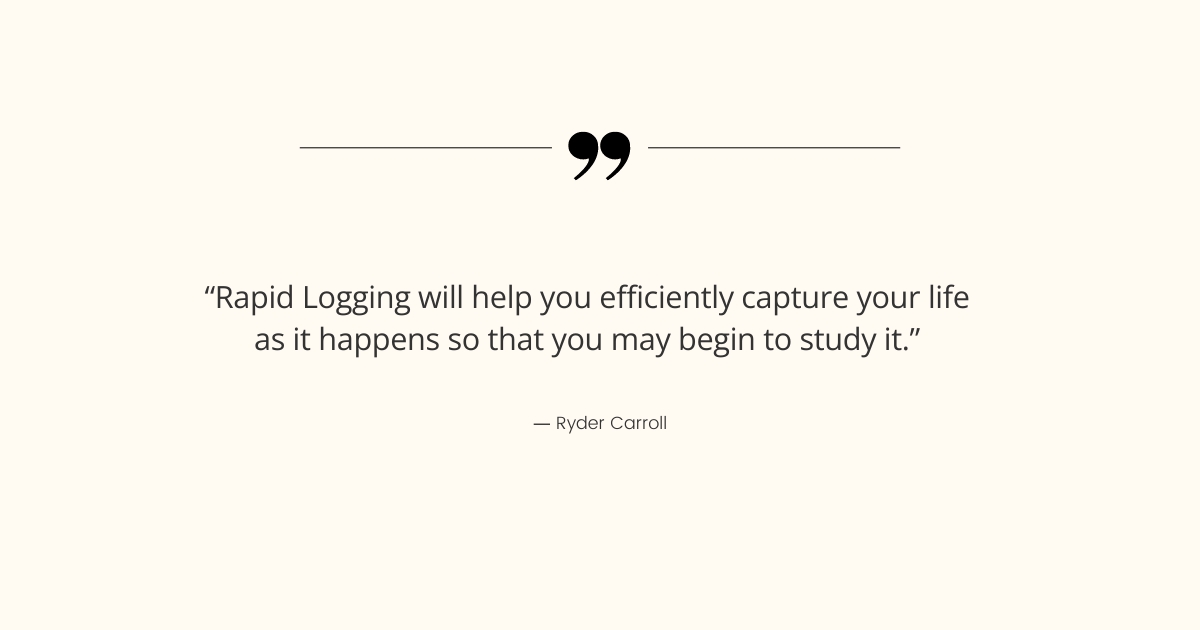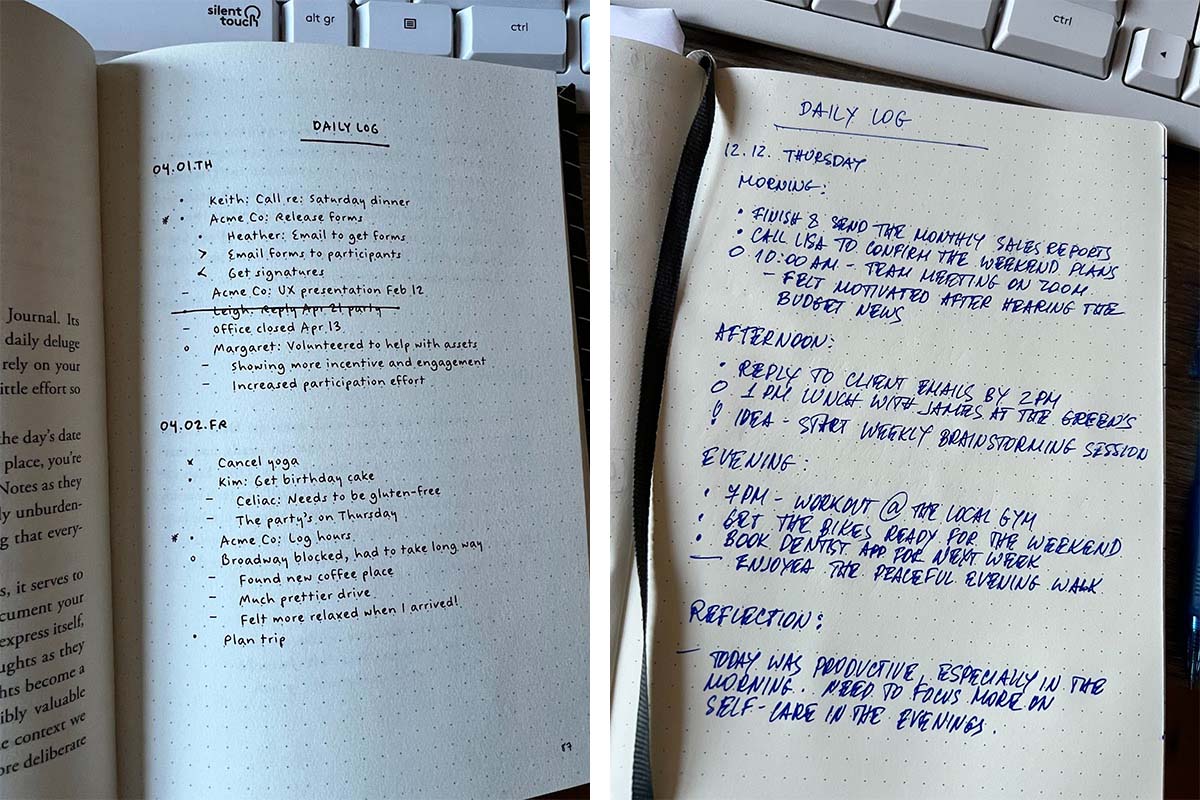
Are you feeling swamped by endless sticky notes, non-stop phone reminders, and a digital calendar that’s more confusing than helpful? If keeping your personal and professional growth goals on track seems like a struggle, rest assured, you’re not alone. But what if I told you that the solution to this clutter and confusion doesn’t lie in yet another high-tech app or complex system? Instead, it’s found in something much simpler – a basic notebook and an easy-to-follow logging system that can transform this chaos into a clear and manageable path toward your goals.
This is the essence of the Bullet Journal method. It’s a refreshingly simple yet remarkably effective blend of a planner, to-do list, and diary. This method is straightforward to start and even easier to maintain. It goes beyond mere daily organization; it’s about creating a customized guide that aligns with your personal and professional aspirations. In the words of its creator, Ryder Carroll, the Bullet Journal method is designed to help you “track the past, organize the present, and plan for the future” – all within the pages of one compact notebook.
Sounds too good to be true? Let’s explore where its mighty power lies.
The Bullet Journal Method Explained
Origin and Philosophy
The story of the Bullet Journal, affectionately known as BuJo, begins with its creator, Ryder Carroll. Carroll, a New York-based designer, created the Bullet Journal method as a personal organization method to manage his ADHD. His primary goal was to create a framework for capturing and organizing information quickly and prioritizing tasks effectively. Over time, the Bullet Journal evolved into a flexible system combining elements of mindfulness, productivity techniques, and personal reflection.
At its core, the Bullet Journal method is centered on the key idea of intentionality.
It’s not just about boosting productivity; it’s about transforming our approach to both daily tasks and long-term aspirations. The Bullet Journal offers a lens through which we can examine our days, providing insight into how we distribute our efforts and energy. It enables us to discern whether we’re investing in tasks that are meaningful and aligned with our goals, or if we’re inadvertently allocating too much time to activities that don’t propel us in our desired direction. This can leave us with scant time for what truly matters. Realizing this might be uncomfortable at times, but gaining awareness of our daily habits is a crucial step towards making any positive changes we aspire to. It’s about cultivating a mindful approach to our actions, ensuring that each day is a step forward in our journey of personal and professional growth. The Bullet Journal is one of the best systems for continuous improvement you can use.
How does the Bullet Journal method work?
The Bullet Journal method, at its heart, is a testament to the power of simplicity in organizing our chaotic lives. It’s a system that thrives on the concept of Rapid Logging – a quick, streamlined way of capturing life’s daily ebb and flow. This method is not about detailed journaling; instead, it focuses on the essence of each task, event, and thought, distilled into concise, manageable entries.
Rapid Logging: The Core Practice

Rapid Logging is the backbone of the Bullet Journal. It’s a method that involves jotting down information swiftly and succinctly, using a unique system of symbols – or Bullets – to categorize and prioritize your entries. This approach transforms the way you capture and interact with your day-to-day life.
Tasks (•): These are actionable items, the things you need to do. Simple, direct phrases like “schedule meeting” or “pay bills” make up this category. The Bullet Journal method encourages you to break down your tasks into bite-sized actions, making them less daunting and more achievable. Here are two examples of tasks represented as actionable items:
- Call the dentist to schedule a check-up.
- Submit monthly report by Friday afternoon.
These tasks are clear, direct, and actionable, making it easy to understand what needs to be done and by when.
Notes (-): These entries capture thoughts, observations, or important information. They can range from reflections to insights and reminders of how we felt. Here are a few examples:
- Reflection Note: “Felt energized and productive after the morning workout. Consider making it a regular routine.”
- Observational Note: “The new coffee blend from the local café has a rich, robust flavor. Great for early mornings.”
- Gratitude Reminder: “Felt grateful for the peaceful morning walk in the park today.”
- Insightful Observation: “Realized that focusing on one task at a time increases my productivity significantly.”
Events (O): These are date-specific occurrences. Unlike traditional diaries, events in the Bullet Journal are logged succinctly, making them easy to track and remember. An essential aspect of the Events Log is its capacity to record all events, regardless of their nature. This includes not only positive or neutral events but also those that are painful or challenging. For instance, jotting down “Got fired” or “She dumped me” serves as a way to acknowledge and temporarily offload these experiences from your immediate thoughts. This method allows you to revisit these events later with more perspective and emotional distance.
Recording events, whether they are joyful, mundane, or difficult, creates over time an authentic roadmap of your life. This practice is particularly valuable as it doesn’t rely on memory alone, which can often be selective or unreliable. By noting down events as they happen, good or bad, big or small, your Bullet Journal evolves into a truthful chronicle of your personal journey.
- O Client Meeting at 3 PM.
- O Sarah’s Wedding on June 24th.
- O Annual Health Checkup on July 15th.
- O Team Offsite Workshop, September 5-7.
- O Webinar: Digital Marketing Trends, April 22nd at 11 AM.
- O Got fired.
- O She dumped me.
Each entry, whether it’s a professional commitment, a personal milestone, or a significant life event, is logged with clarity and brevity. This approach not only helps in staying organized and prepared but also in reflecting on and understanding the various experiences that shape our lives.
Daily Log: Capturing the Now
Following the principle of Rapid Logging, the Daily Log is where the Bullet Journal truly comes to life. It’s the everyday workspace where you capture and organize your immediate tasks, events, and notes. Think of the Daily Log as a living, breathing snapshot of your day, constantly evolving as your day unfolds.
The beauty of the Daily Log lies in its simplicity. Each day starts with a fresh page, dated for reference. Here, you rapidly log tasks, events, and notes as they occur, using the Bullet system to categorize and prioritize. This method keeps your day’s agenda clear and concise, allowing for quick review and action.
Here’s an example from the Bullet Journal Method book of what a Daily Log might look like:

In this Daily Log, tasks are marked with a bullet (•), events with a circle (O), notes/thoughts with a dash (-), and ideas with (!). The log is divided into morning, afternoon, and evening sections for better organization, but this structure can vary based on personal preference. The day ends with a brief reflection, which is a great way to assess the day and plan for the next.
Monthly Log
The monthly log offers a broader perspective, enabling you to plan and track your activities, goals, and events throughout the month. To create a monthly log, designate a double-page spread in your notebook for each month.
On the left-hand page, write the name of the month at the top and list the dates (1-28/31) down the side. Use this space to mark important events, deadlines, or appointments for each day. On the right-hand page, create a monthly task list, where you can list out tasks, goals, or projects you want to focus on during the month.
Here’s another example from Carroll’s Bullet Journal Method book of what a Monthly Log might look like:

The monthly log serves as a reference point, allowing you to see the big picture and plan ahead. As the month progresses, you can refer to this log, migrate tasks to specific days in your daily log, or add new tasks as they arise. But what’s more important is that you can use the monthly log as a habit-tracking tool that seamlessly integrates with the rest of your life.
How to Track Habits in Your Bullet Journal Monthly Log
To track habits in your Bullet Journal, all you have to do is set up a simple habit tracker using your Monthly Log and map your habits on the existing dates of the month.
Here is how to do it:
- Begin by setting your Monthly Log as described in the section above.
- Create a key (below the dates of the month) using the first letter of each habit you are going to track. For example E = Exercise; S = Sleep (went to bed on time); F = Food (No Junk Food), M = Meditate, W = Write, etc.
- Copy the key next to the name of the month at the top of the page, do this on the inner edge of the notebook to leave room for calendar events.
- To track your habits you can use the task bullet (•) or a check mark (✔). This serves two purposes: one to mark off each time you complete the action related to the habit, and two, to schedule the days you will take the action.
Here is how this can look in practice:
Source: YouTube / Bullet Journal
What to do when habits don’t stick?
The reality of our efforts is that they don’t always match what we have planned to do. Life happens to all of us. So what options do we have when things don’t go as planned and we miss performing a habit on a day we have planned to do? What most of us default to is beating ourselves up, internalizing words like “failure”, quit, and gain nothing.
But what if instead we try something radically new – give ourselves credit for what we did, acknowledging the days we have showed up and performed the habit, and like a GPS reroute ourselves back on track on track every time we go astray?
So when you don’t do as well as you hoped, schedule your next week’s actions based on what you learned from the previous week. Maybe working out three days a week was too much to begin with, then scale it down to two days and see how you go. Give yourself the freedom to do more or less if you want to. Doing this by the end of the month, you’ll have four weeks to figure out what works for you. This is the basic principle of continuous improvement.
Integrating your habit tracker with your Monthly Log timeline you can easily see a correlation between the events that happen to you during the month and how well you stick to your habits. Working late didn’t leave time for a workout? How often did that happen? A quick look at your Monthly log and habit tracker will help you determine what needs to change for your habits to stay. Sometimes this will require taking uncomfortable steps like saying no to extra work to free up time for a workout. Setting boundaries can be difficult at first but you gain so much from it that in some cases it feels like you have gained your life back.
What Sets the Bullet Journal Method Apart?
The Power of Simplicity
What sets the Bullet Journal apart is its emphasis on brevity and clarity. You’re not writing full sentences or detailed accounts. Instead, you’re distilling information to its core. This brevity is key to the system’s effectiveness. It allows you to quickly log entries without getting bogged down, making it more likely that you’ll stick with the practice.
Flexibility and Adaptability
One of the most appealing aspects of the Bullet Journal is its adaptability. There’s no rigid structure you must adhere to. You can mix tasks, events, and notes in a way that suits your day and your life. This flexibility means that your Bullet Journal evolves with you, always fitting your current needs.
A Tool for Mindfulness and Intentionality
Beyond its practicality, the Bullet Journal method is a tool for mindfulness. By encouraging you to log your tasks and thoughts concisely, it also invites you to consider their importance and relevance. This practice fosters a habit of reflection and intentionality, helping you to focus on what truly matters and align your daily actions with your larger life goals.
There is so much more to be said about the Bullet Journal Method, and I highly recommend that you read Ryder Carroll’s book to dive deeper into its transformative power. This method is more than a series of entries on paper; it’s a journey of self-discovery, a canvas for your thoughts, and a reflection of your daily life. In the simplicity of its pages lies a powerful ally in your quest for personal and professional growth.
The Bullet Journal method isn’t just about tracking tasks or jotting down events; it’s about understanding the rhythm of your life. It respects the fluidity of your days, adapts to your changing needs, and grows with you. Each page, each entry, is a step towards a more mindful, intentional existence. It’s about recognizing the beauty in the mundane, learning from setbacks, and celebrating the small victories.
Over time, the Bullet Journal becomes a testament to your resilience, a collection of your triumphs and trials, and a guide to your aspirations. It’s a method that doesn’t just organize your life; it enriches it.
So, as you close one journal and open another, remember that each page is a new opportunity. An opportunity to redefine priorities, to capture fleeting moments, and to sketch the blueprint of your dreams. The Bullet Journal is not just a notebook; it’s a companion on your journey toward a more organized, fulfilled, and mindful life.
In the words of Ryder Carroll, “It’s not about how your journal looks; it’s about how it makes you feel and how effective it is.” As you continue on your Bullet Journal journey, may it bring you clarity, purpose, and joy. Here’s to the pages yet to be written, the goals yet to be achieved, and the journey yet to be enjoyed.
The Bullet Journal Method is a voyage into the heart of what matters most in your life, and I encourage you to embark on this adventure with an open heart and an eager pen.

Paul Strobl, MBA, CPC
Owner of Confide Coaching, LLC
Paul is a Master Life Coach for individuals, executives and business owners. Originally from Houston, Texas, he has been location independent for most of his adult life. He currently resides in the Rhodope Mountains of Bulgaria near the Greek border with his brilliant wife, 13-year-old stepson (officially adopted in 2021!) and a Posavac Hound rescue.
References
Carroll, R. (2018). The Bullet Journal Method: Track the Past, Order the Present, Design the Future. Portfolio.

